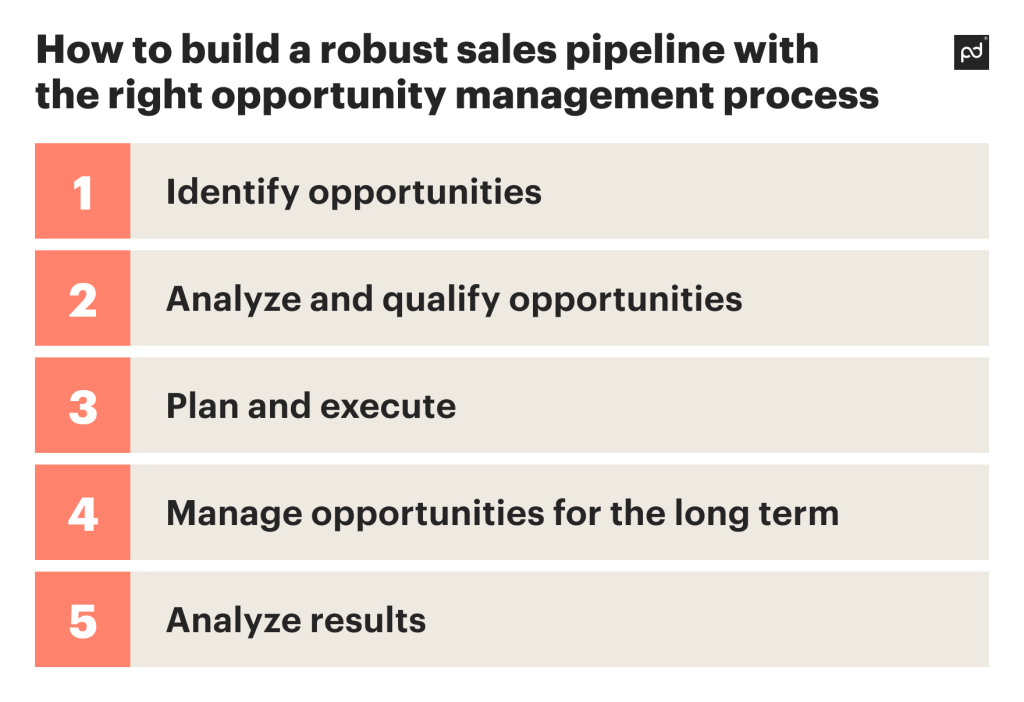Leads, opportunities, sales: That’s the natural sequence of the sales process, right?
But opportunities can be much more than that.
All you need to do is zoom out, see the bigger picture and start looking for long-term growth and expansion possibilities rather than focusing only on short-term conversion objectives.
Below, we’ll discuss the impact that a robust opportunity management process can have on your bottom line.
Key takeaways
- Opportunity management is not exactly the same as lead management, although the two processes are similar. Lead management focuses on achieving sales goals in the short to medium term, while opportunity management is more about leveraging strategic relationships to achieve long-term growth goals.
- Automation is fundamental to building a robust sales pipeline; document management tools fused with CRM software accelerate this process.
- Opportunity management relies on building strong relationships, so relationship building is central to your success.
What is opportunity management — and why should you care?
Opportunity management is an approach that focuses on identifying and managing business opportunities for client acquisition, market expansion, strategic partnerships, and more.
It enables organizations to:
- Be proactive in anticipating market trends
- Adapt to customer demands and seize possibilities before competitors
- Build partnerships that can help with long-term expansion and growth
- Create strong relationships with prospective and existing customers
Lead management vs. opportunity management: What are the differences?
Although sales and opportunities are often used synonymously, they’re not the same.
Opportunity management isn’t necessarily about immediate transactions or closing deals, which is the goal of traditional sales and lead management processes.
Instead, it’s about recognizing and nurturing all sorts of potential avenues for growth — which may or may not be related to sales in the near future.
Here’s how the two compare:
| Opportunity management | Lead management | |
|---|---|---|
| Key focus | Long-term growth and relationship building | Customer acquisition and sales |
| Goals | Leveraging opportunities for sales, partnerships, and market expansion | Converting leads into customers |
| Related activities | Identifying potential high-value partnerships, uncovering new market opportunities, relationship building, sales | Lead generation, qualification, and nurturing; sales; retention |
| Metrics | Long-term growth, market expansion, brand awareness | Conversion and retention rates |
| Types of software used | CRM systems | CRM systems |

Opportunity management supports and supplements your lead gen and sales processes by building long-term relationships that can help unlock growth in the future.
To use it to build a robust sales pipeline, you need to:
1. Identify opportunities
The first step of the opportunity management process is identifying opportunities — i.e., deciding which ones make the most sense for your business and are worth pursuing.
For this, ask questions like:
- Is this a potential new client or partner?
- What potential deals could result from building this relationship? What’s their business value?
- What will this opportunity bring me in terms of results (revenues, exposure, market penetration, etc.)?
- What strategic goals can it help me achieve?
- What’s the effort needed to pursue this opportunity?
- What ROI could we expect from this?
To help answer these questions, you can use customer relationship management (CRM) software: Once you identify a new opportunity, you can add it to your CRM and add notes to facilitate future sales activities related to it.
2. Analyze and qualify opportunities (use data-driven insights)
Next, you need to dig deeper into each opportunity’s potential.
To streamline the process, you can use a spreadsheet that looks something like this:
| Opportunity #1 | Opportunity #2 | Opportunity #2 | |
|---|---|---|---|
| Potential | Very high | Moderate | Moderate-low |
| Engagement level | Moderate | High | Low |
| Point of contact | CTO (key decision-maker) | Marketing manager (secondary decision-maker) | External consultant (limited influence on the decision-making process) |
| Sales stage | Qualification | Negotiation | Proposal |
| Expected close date | end of 2024 | Q1-Q2/2024 | Q1/2024 |
| Competitor presence | Yes | Unknown | Yes |
| Next step | Schedule a demo | Update proposal | Follow up |
To populate it, use data from your CRM — or, even better, add all the info directly into your CRM to keep everything updated in real time and not waste time switching between systems.
Many CRM systems enable you to define custom fields and fill those out.
3. Plan and execute
The analysis you’ve conducted at the previous step will inform your next actions and help you define the order in which you execute your strategy; you can also use a sales pipeline prioritization formula for this.
In the end, your action plan could look like this:
- Focus on all high-potential opportunities
- Explore opportunities with moderate potential that require a low effort
- Move on to opportunities with moderate potential that require a lot of effort
- Follow up on opportunities with low potential that require a low effort
You might decide to completely disregard opportunities that have a low potential for success and require a lot of effort to follow through.
At this stage, you also need to make sure you have the right opportunity management tools. A winning combination is a robust proposal management software like PandaDoc and a CRM like Salesforce, Pipedrive, or Zendesk Sell.
Make sure you pick tools that play well with each other, i.e., those that have the necessary integration capabilities in place.
Hint: PandaDoc does; we have sales integrations for all major tools on the market.
Additionally, using the right templates for your proposals, quotes, and contracts is essential for moving quickly at this stage and not letting deals fall through the cracks simply because your sales team didn’t have the capacity to prepare the right documents and follow up on time.
4. Manage opportunities for the long term
Opportunity management can be a fairly long process; each opportunity could take a few months to mature and result in a deal.
That’s why the process of tracking opportunities and following up is so essential.
To automate it, you could set up notifications and even email campaigns in your CRM — but make sure you don’t end up sending automated messages that are no longer relevant to your customer’s needs.
Check each deal’s status before you send out the next email.
5. Analyze results
Next, analyze the results of your opportunity management efforts.
Focus on:
- Effort required to pursue each opportunity (number of touchpoints, number of people who were involved)
- Return on investment of your efforts
- Conversion rates
- Length of the sales cycle
In PandaDoc, you can use our reporting functionality to better understand your document funnel.
You can find information about the proposals or quotes you’ve created or sent, how many of them were viewed and signed, and also how long your entire document workflow takes.
Top 5 opportunity management best practices and hot tips
To make the most of each opportunity that you encounter, there are some best practices you should follow:
Use the right tools
In lengthy business processes, having the right tools is essential.
A CRM plus the right contract management software can help you manage leads efficiently and in a fraction of the time you’d need if you do everything manually.
This is especially helpful when it comes to automating your workflows.
Set clear criteria for opportunity evaluation
To better visualize which opportunities are worth investing in and how to prioritize them, define a transparent and consistent evaluation process.
Think about the big picture
Effective opportunity management should help you achieve your strategic business goals, not distract you from them.
Always make sure that opportunities align with your overall objectives.
Build strong relationships
In the age of AI, relationships are more important than ever.
Focus on actually talking to people and getting to know their pain points to provide solutions that are exactly right for them.
Use a personalized approach
All the reminders, follow-ups, and documents you send need to:
a) help you build a consistent brand image and
b) be personalized to your leads’ requirements/expectations.
PandaDoc enables you to achieve both of those things at once and build personalized, on-brand documents, on which you can collaborate with team members and key stakeholders on the other side of the process.
Build a robust opportunity management process with the right tools
To pursue the most attractive opportunities swiftly and efficiently, you need a combination of the fine-tuned processes and top-notch tools to enable your people to do their best work.
Both of these factors are essential.
In the same way that you’re unable to build a solid sales pipeline with a wobbly process — a scenario where no one knows who’s responsible for what, how to follow up, or when — you also can’t expect to optimize your sales pipeline relying on old-school tables that sales people send to each other as email attachments.
To do business the modern way, you need a robust solution that enables you to manage proposals, quotes, and contracts all at once — and also one that connects easily to your CRM.
PandaDoc does all that, and more.
Sign up for a 14-day trial or schedule a demo today to start optimizing your opportunity management workflows!


